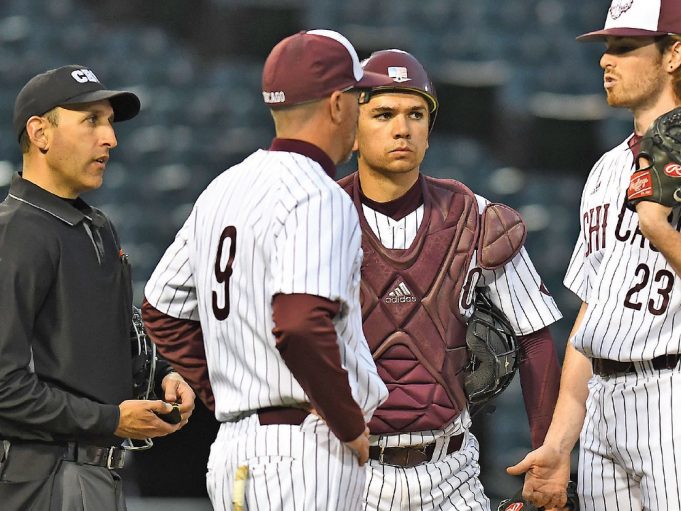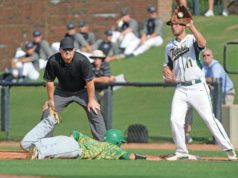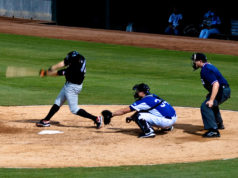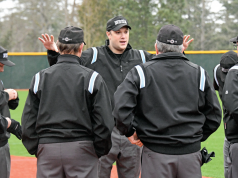The emphasis on pace of play in both pro and NCAA has resulted in significant changes to the traditional rules on conferences to include visits to the mound. Even at the high school level, where there have been no recent changes, umpires have been confused as to the legality of a mound visit. Except where noted, the material applies equally to NFHS, NCAA and pro rules.
Under NFHS rules, three charged defensive conferences are allowed for a regulation game. A conference is a visit between a coach (or anyone else from the dugout) with at least one player (2-10-1). Those conferences can be used at any time to include during the same at-bat with the same pitcher. Once the allowed conferences are used, the pitcher must be removed on any subsequent visits to the mound. In extra innings, each team receives an additional conference per inning; unused conferences do not carry over (NFHS 3-4-1).
NCAA and pro consider any meeting between defensive players as a conference. Each team is allowed six defensive conferences per game in NCAA; five in pro. In NCAA only, no more than three of them may include a coach. If the game goes into extra innings, each team receives one extra defensive conference and any unused conferences from the first nine innings (NCAA 6-5f, pro 5.10m).
What is a conference? In NCAA and pro, a charged defensive conference can be any act that delays a game. The three non-coach defensive conferences are primarily for the catcher, but also apply to any player who leaves his position to confer with the pitcher, including a pitcher leaving the mound to confer with another player, regardless of where the visit occurs or the length of the visit. The pitcher need not be involved. If a manager or coach confers with another defensive player, it constitutes a “coach trip” whether the player goes to the mound or not. Also, simply calling timeout could be a conference.
The following are not considered visits: discussions between pitchers and players that occur between batters in the normal course of play and do not require either the player or the pitcher to relocate, or delay the game; visits by players to the mound to clean spikes in rainy conditions; visits to the mound due to an injury or potential injury of the pitcher; visits to the mound after the announcement of an offensive substitution; or any other incidental communication.
In the event of a possible injury, such as immediately after the pitcher has been struck with a batted ball, the umpire should monitor the discussion to ensure strategy, etc., is not discussed. Any such chat should be immediately stifled and the coach warned that a visit will be charged if he continues.
In the event a team has exhausted its allotment of mound visits and the home plate umpire determines that the catcher and pitcher did not have a shared understanding of the location or type of pitch that had been signaled by the catcher (crossed-up signals), the home plate umpire may, upon request of the catcher, allow the catcher to make a brief mound visit. However, any mound visit resulting from a “cross up” prior to a team exhausting its allotted number of visits shall count against a team’s total number of allotted mound visits.
In all cases, if all conferences have been used and an infielder requests time to talk to the pitcher, the umpire should remind him no conferences remain. Preventive officiating is paramount and it’s important for base umpires to know the number of visits taken. Inadvertent conferences should be immediately stopped without penalty. If an extra conference is held, the non-pitcher is removed from the game; however, if a player continues to confer in defiance of authority after an umpire has advised no visits are remaining, the player is ejected.
A mound visit that results in a pitching change is not a charged conference; however, if the pitcher is removed after the third free trip, he must be removed from the pitcher’s position for the remainder of the game (NCAA 9-4b Nt 1, pro 5.10m1).
In NCAA and pro, a second trip can be made in the same inning to talk to the same pitcher, but the pitcher must be removed from the pitcher’s position for the remainder of the game (NCAA 9-4b, pro 5.10L2). A second trip cannot be made in the same inning to talk to the same pitcher while the same batter is at bat, except if there is a pinch hitter, the second trip is legal, but the pitcher must be removed from the pitcher’s position for the remainder of the game (NCAA) or from the game (pro). For purposes of this rule, the next batter is the batter as soon as the previous batter finishes his at-bat (NCAA 9-4c, pro 5.06L3, 4). The coach need not wait for the new batter to step into the box before coming out. As mentioned, in high school play, the preceding is not applicable as all three conferences can be held in the same inning with the same pitcher and the same batter.
If an attempt is made to visit the pitcher in violation of the rules, the umpire should so advise the coach. If the coach continues to the mound, the only recourse is ejection. If the coach is mistakenly allowed to go to the mound for a conference that dictates removal of the pitcher, there is no penalty. In either case the pitcher may remain until the batter completes the turn at bat and the umpires should announce the consequences so a new pitcher can warm up.
In NFHS, if a coach visits with his pitcher between half innings, it doesn’t count as a trip unless the game is delayed. If there is a delay, it is recommended the coach be warned that he will be charged with a trip on the next occurrence. In NCAA, such a visit is permissible subject to the 120-second count. In pro, it is a charged visit.
If the offense asks for time, and a coach visits the pitcher, it counts as a trip in NCAA and pro, but not in NFHS. However, NCAA rules specifically allow a coach to chat with his pitcher during a prolonged injury timeout without a charged conference. In a prep game, the coach may come out and talk to his pitcher during an offensive conference as long as the game is not delayed (NFHS 3-4-5, NCAA 9-4a6).
What's Your Call? Leave a Comment:
Note: This article is archival in nature. Rules, interpretations, mechanics, philosophies and other information may or may not be correct for the current year.
This article is the copyright of ©Referee Enterprises, Inc., and may not be republished in whole or in part online, in print or in any capacity without expressed written permission from Referee. The article is made available for educational use by individuals.


















